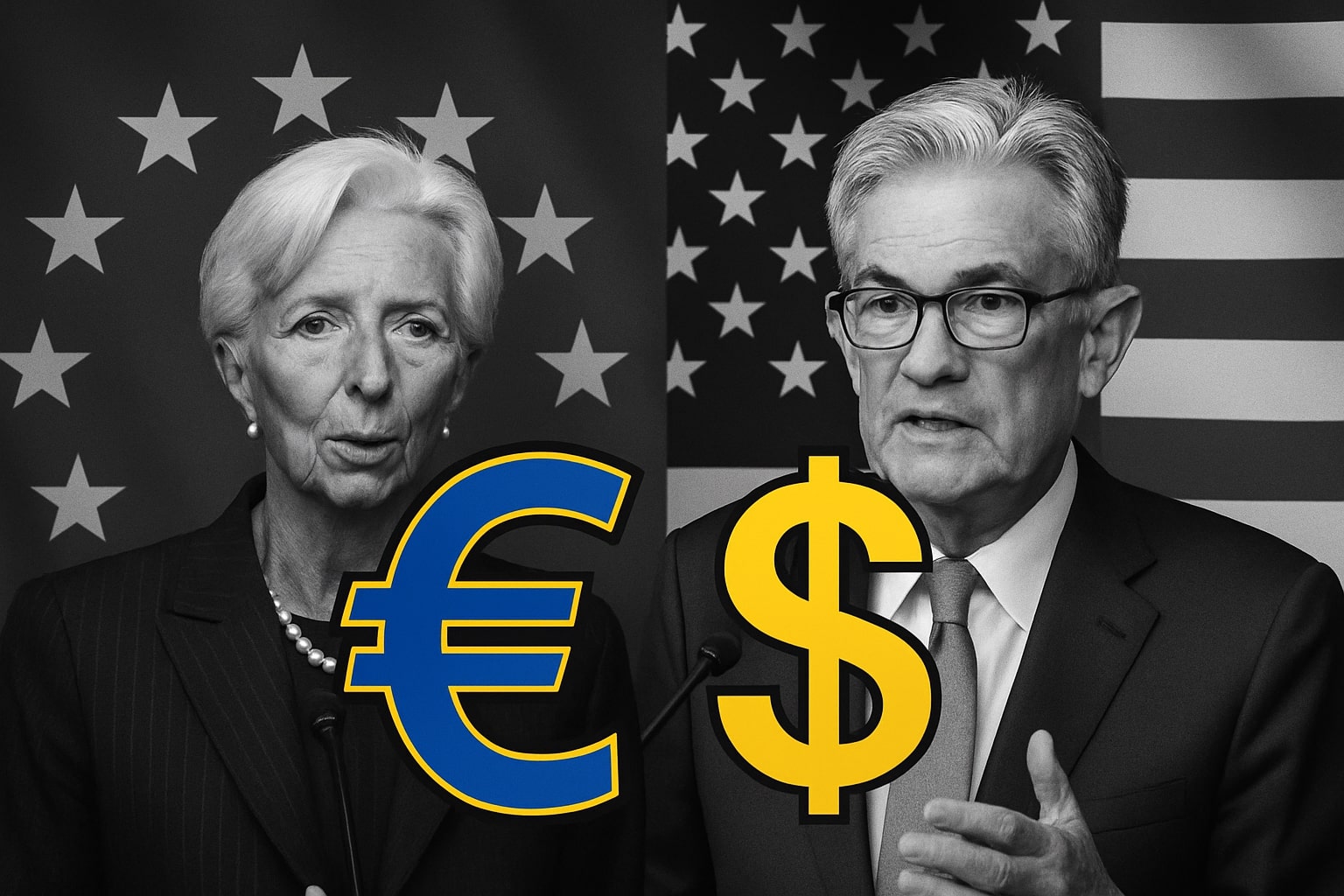
EUR/USD Price Forecast - Euro Slides to 1.1597 As Strong Dollar and Fed Repricing Pressure Euro
The euro holds near 1.16 amid hawkish Fed tone and falling rate-cut odds; traders eye 1.1570 support and 1.1720 resistance ahead of pivotal NFP release | That's TradingNEWS
EUR/USD (Euro/US Dollar) Struggles Near 1.16 As Dollar Strength and Fed Repricing Cap Gains
The EUR/USD pair remains pinned near 1.1597, marking its fourth consecutive session of subdued trading as investors brace for crucial U.S. Nonfarm Payrolls (NFP) data later this week. The euro continues to hover just below the 1.1600 psychological level, reflecting a tense balance between resilient dollar demand and muted eurozone momentum. The U.S. dollar’s strength, supported by hawkish Federal Reserve rhetoric and cautious risk sentiment, has kept the pair within a narrow corridor — unable to break the descending trendline that has capped every rally since late September.
The U.S. Dollar Index (DXY) trades around 99.46, recovering from last week’s low amid renewed defensive positioning. Traders have dialed back expectations for a December rate cut to 43%, down from 62%, following comments from Fed Governor Christopher Waller and Vice Chair Philip Jefferson, who warned that the slowdown in hiring could signal labor “stall speed.” The Fed’s reluctance to pre-commit to easing has pressured risk-sensitive currencies, keeping the euro pinned despite oversold conditions.
Across the Atlantic, eurozone fundamentals remain stagnant. The European Central Bank’s policymakers maintain a cautious tone, with most members leaning toward holding rates steady. The EU September Current Account and the October HICP final estimate—both due this week—are unlikely to alter expectations of policy inertia. This lack of catalyst has left the euro vulnerable to U.S. macro forces, particularly employment and inflation releases.
Technical Landscape: EUR/USD Defends 1.1570 but Resistance Layers Thicken
Technically, the EUR/USD structure shows clear congestion between 1.1570 support and 1.1650 resistance. The pair trades slightly above its 100-period SMA on the 4-hour chart, yet remains capped beneath both the 20- and 200-period SMAs, located near 1.1610. The short-term trend is neutral-to-bearish, with momentum indicators signaling a pause rather than a reversal.
The RSI holds near 48, reflecting limited selling pressure, while the Momentum oscillator trends downward. The daily chart reinforces this equilibrium: the 20-SMA flattens near 1.1600, while the 100-SMA at 1.1655 caps any advance attempts. The 200-SMA, still upward sloping but losing pace, underscores the medium-term bias toward gradual consolidation rather than a sustained breakout.
For traders, immediate supports are found at 1.1570, 1.1540, and 1.1510, while resistance lies at 1.1610, 1.1655, and 1.1690. A decisive close above 1.1720 would mark a significant shift in momentum, potentially opening a path to 1.1810, but as long as price remains trapped beneath the descending trendline from 1.1818, each bounce risks fading into renewed selling pressure.
Market Dynamics: Jobs Data and Fed Policy Steer Near-Term Volatility
The upcoming U.S. September NFP report is the key catalyst. Economists forecast a 50,000 job increase, following the 22,000 rise in August, with unemployment expected to hold near 4.3%. A stronger print would likely boost the dollar, dragging EUR/USD toward 1.1540–1.1500, while weaker numbers could spark short-covering toward 1.1670–1.1710.
The NFP release is particularly critical after the six-week U.S. government shutdown delayed vital labor and inflation data. The reopening has reintroduced regular data flow, and markets are recalibrating policy forecasts accordingly. Fed officials including Richmond’s Thomas Barkin and Vice Chair Michael Barr are scheduled to speak before the data, potentially shaping short-term expectations.
Eurozone Under Pressure as Growth Momentum Weakens
The euro area continues to underperform relative to the U.S., burdened by stagnant growth and fading industrial output. ECB President Christine Lagarde has emphasized caution, stating that inflation remains subdued but warned against assuming policy room for aggressive cuts. The Eurozone Current Account remains positive but narrow, while weak exports and slowing German factory data limit near-term optimism.
Investors are watching for signs of recovery in the HICP inflation data due Wednesday, but forecasts suggest minimal changes near 2.4% year-over-year, insufficient to spark directional momentum. Without fresh economic catalysts from Europe, traders continue to position EUR/USD reactively to U.S. macro indicators.
Volatility Compression Reflects Market Caution
Volatility across FX markets has tightened significantly. The EUR/USD pair’s Average True Range (ATR) has dropped to 42 pips, the lowest since early August. This compression often precedes sharp directional breakouts once data or policy shocks emerge. For now, traders describe the market as “coiled,” with most short-term strategies focused on scalping narrow intraday ranges around 1.1580–1.1620.
The RSI remains rangebound between 40 and 55, mirroring the lack of conviction from either bulls or bears. However, longer-term traders continue to note that the pair has respected the ascending trendline from 1.1184, preserving a medium-term bullish structure that would remain valid as long as the 1.1500 handle holds.
U.S. Dollar (DXY) Resilience Caps Euro Rebounds
The broader Dollar Index (DXY) remains firm near 99.50, supported by risk aversion across global markets. The index trades within a descending channel but has consistently found support around 99.00–98.65. Technical resistance at 99.70 and 100.02 remains a ceiling for now, yet any upside break would likely extend the euro’s decline.
The DXY’s RSI near 50 suggests balanced momentum, but the combination of soft equities and weak commodities continues to attract defensive capital flows into the dollar. This dynamic limits the euro’s ability to capitalize even on dovish Fed remarks.
Read More
-
NVIDIA Stock Price Forecast - NVDA Shares Balances $4 Trillion AI Growth With Market Anxiet
18.11.2025 · TradingNEWS ArchiveStocks
-
XRP Price Forecast - XRP-USD Battles $2.23 As $245M XRP ETF Inflows Clash With Whale Selling
18.11.2025 · TradingNEWS ArchiveCrypto
-
Oil Price Forecast - WTI And Brent Fall To $60 As Oversupply Builds And OPEC+ Holds Output Steady
18.11.2025 · TradingNEWS ArchiveCommodities
-
Stock Market Today - NVDA, MSFT, AMZN Lead Wall Street Drop as Nasdaq Hits 22,471, Dow 46,136
18.11.2025 · TradingNEWS ArchiveMarkets
-
GBP/USD Price Forecast - Pound Steadies At 1.3160 As Traders Brace For UK CPI And U.S. NFP
18.11.2025 · TradingNEWS ArchiveForex
Technical Barriers and Key Fibonacci Zones Define EUR/USD Path
The EUR/USD remains confined within major Fibonacci retracement zones. From the 1.1184–1.1822 range, the 0.382 retracement lies near 1.1500, while 0.618 sits at 1.1680, both defining the pair’s immediate boundaries. The rejection near 1.165–1.168 last week reaffirmed this resistance band as a heavy supply zone. A clean breakout above 1.1720 would signal a structural reversal, while a breach below 1.1540 could accelerate losses toward 1.1340, aligning with summer’s consolidation base.
Investor Positioning and Derivatives Flows Indicate Neutral Bias
Futures data from the Chicago Mercantile Exchange (CME) show that euro long contracts declined 3.4% week-over-week, while shorts rose 5.1%, narrowing net positioning to just +4,200 contracts. This neutral positioning highlights market indecision rather than aggressive directional conviction. Option-implied volatility around 6.7% (1-month tenor) remains historically low, indicating traders are not yet pricing in large post-NFP moves.
TradingNews Verdict: EUR/USD Neutral-to-Bearish Short Term, Hold Bias into Data
The EUR/USD pair’s inability to break above 1.1650 confirms short-term bearish control. With Fed cut odds shrinking and the dollar anchored near 99.50, the path of least resistance remains lower into the 1.1540–1.1500 region. However, the pair’s repeated defense of 1.1570 suggests underlying accumulation ahead of key macro catalysts.
From a tactical perspective, traders favor selling rallies toward 1.1650–1.1680 with stops above 1.1720, while patient buyers may consider accumulating near 1.1510–1.1540 for a medium-term rebound if U.S. data underperforms.


















